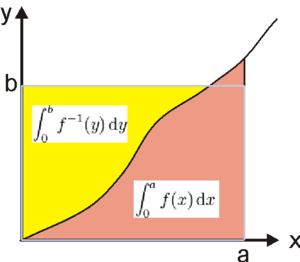متراجحة يونگ لحواصل الضرب
متراجحة يونگ Young inequality مبرهنة رياضية تقول مايلي:
حيث a و b مصفوفتان و عدد طبيعي أكبر من صفر.
لهذه المتراجحة تطبيقات عديدة في البراهين الرياضياتية وفي نظرية التحكم القوي.
. . . . . . . . . . . . . . . . . . . . . . . . . . . . . . . . . . . . . . . . . . . . . . . . . . . . . . . . . . . . . . . . . . . . . . . . . . . . . . . . . . . . . . . . . . . . . . . . . . . . . . . . . . . . . . . . . . . . . . . . . . . . . . . . . . . . . . . . . . . . . . . . . . . . . . . . . . . . . . . . . . . . . . . .
التعميم المصفوفي
T. Ando proved a generalization of Young's inequality for complex matrices ordered by Loewner ordering.[1] It states that for any pair A, B of complex matrices of order n there exists a unitary matrix U such that
where * denotes the conjugate transpose of the matrix and .
النسخة القياسية للدوال المتزايدة
For the standard version[2][3] of the inequality, let f denote a real-valued, continuous and strictly increasing function on [0, c] with c > 0 and f(0) = 0. Let f−1 denote the inverse function of f. Then, for all a ∈ [0, c] and b ∈ [0, f(c)],
with equality if and only if b = f(a).
With and , this reduces to standard version for conjugate Hölder exponents.
For details and generalizations we refer to the paper of Mitroi & Niculescu.[4]
التعميم باستخدام تحويلات فنشل-لجاندر
إذا كانت f هي convex function و تحويل لجاندر لها (convex conjugate) مميز بالحرف g، إذن،
This follows immediately from the definition of the Legendre transform.
More generally, if f is a convex function defined on a real vector space and its convex conjugate is denoted by (and is defined on the dual space ), then
where is the dual pairing.
أمثلة
- The Legendre transform of f(a) = ap/p is g(b) = bq/q with q such that 1/p + 1/q = 1, and thus Young's inequality for conjugate Hölder exponents mentioned above is a special case.
- The Legendre transform of f(a) = ea – 1 is g(b) = 1 − b + b ln b, hence ab ≤ ea − b + b ln b for all non-negative a and b. This estimate is useful in large deviations theory under exponential moment conditions, because b ln b appears in the definition of relative entropy, which is the rate function in Sanov's theorem.
انظر أيضاً
الهامش
- ^ T. Ando (1995). "Matrix Young Inequalities". In Huijsmans, C. B.; Kaashoek, M. A.; Luxemburg, W. A. J.; et al. (eds.). Operator Theory in Function Spaces and Banach Lattices. Springer. pp. 33–38. ISBN 978-3-0348-9076-2.
- ^ Hardy, G. H.; Littlewood, J. E.; Pólya, G. (1952) [1934], Inequalities, Cambridge Mathematical Library (2nd ed.), Cambridge: Cambridge University Press, ISBN 0-521-05206-8, http://www.cambridge.org/catalogue/catalogue.asp?isbn=9780521358804, Chapter 4.8
- ^ Henstock, Ralph (1988), Lectures on the Theory of Integration, Series in Real Analysis Volume I, Singapore, New Jersey: World Scientific, ISBN 9971-5-0450-2, https://archive.org/details/lecturesontheory0000hens, Theorem 2.9
- ^ Mitroi, F. C., & Niculescu, C. P. (2011). An extension of Young's inequality. In Abstract and Applied Analysis (Vol. 2011). Hindawi.















